User:MTGap: Difference between revisions
No edit summary |
No edit summary |
||
| Line 56: | Line 56: | ||
==== Notifications ==== | ==== Notifications ==== | ||
KTTS works with any application that uses notifications. To set this up start an application such as Konversation that uses notifications. In the menu go to 'Settings' > 'Configure Notifications...' | |||
[[Image:KTTS-Notification2.png|400px|center]] | [[Image:KTTS-Notification2.png|400px|center]] | ||
As you can see you can have various notifications for different events, such as when someone triggers a highlight. By selecting it to speak for this event it will notify you through audio output each time this event happens. Of course you can also have more than one notification. | |||
Revision as of 23:01, 9 January 2010
Template:I18n/Language Navigation Bar
 |
The KDE Text-To-Speech System, KTTS |
Features
- Converts text into audio
- Highly Configurable
- Substitute misspoken words
- Choose speech synthesizers
- Configure Audio Output
- Manage Jobs
- Runs in the System Tray
- Integrates with most KDE applications
- Speak text from clipboard
- Speak all or sections of text file in Kate
- Speak all or sections of HTML page in Konqueror
- Can be used for notifications (KNotify)
Description
KDE Text-To-Speech System or KTTS is an application that can run in the background to provide speech output of text throughout the desktop. It integrates with many applications and is simple to use.
Setup
Once installed you can start KTTS by going to your applications menu and under Utilites open kttsmgr. Or just start KRunner 'Alt+F2' and run 'kttsmgr'. KTTS is not initially setup and you will need to do this before using its speaking abilities.
The first step is to make sure you have a compatible speech engine installed. The following synthesizers are compatible with KTTS: Festival, Festival Lite (flite), Hadifix, Epos, and FreeTTS. Any engine that can be run from commandline can also be used with KTTS.
Now you can continue on and create a 'Talker.' Select the tab Talker from the Text-to-Speech Control Module and click 'Add.'
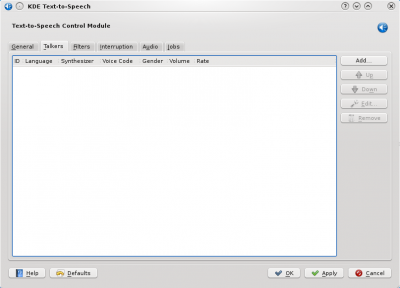
Select which language and synthesizer to use. You will need to have a voice installed to use Festival, you can configure this afterwards by selecting the 'Edit' button. KTTS should now be setup and test it by selecting 'Edit' and then 'Test.'
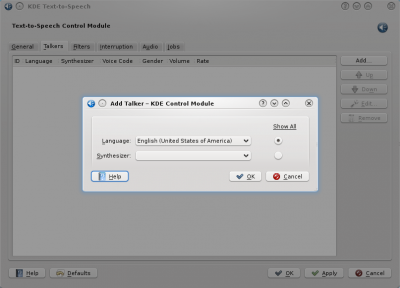
Configuration
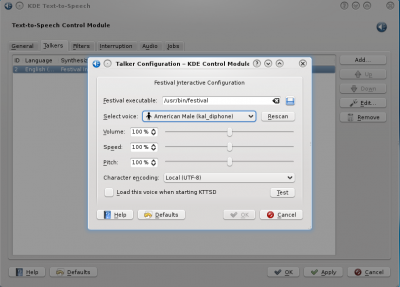
Using KTTS
System Tray
If enabled in the configuration, KTTS will be availabe to you in the System Tray. Right-clicking it will reveal the menu which is straight forward and allows for control of the speech output.
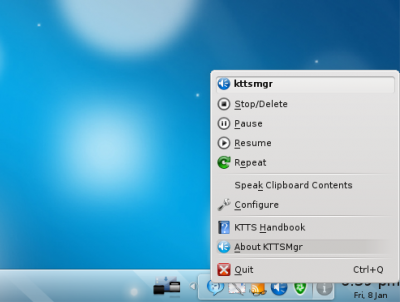
Notice the 'Speak Clipboard Contents' in the menu, if the application isn't integrated with KTTS (Read more about the applications with KTTS built-in in the next section) you can copy the text you want spoken, and click 'Speak Clipboard Contents' to hear it read.
Integration with other Desktop Applications
Notifications
KTTS works with any application that uses notifications. To set this up start an application such as Konversation that uses notifications. In the menu go to 'Settings' > 'Configure Notifications...'
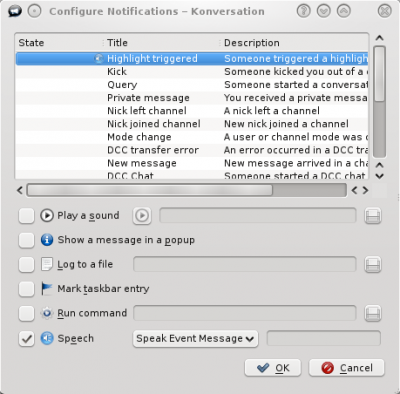
As you can see you can have various notifications for different events, such as when someone triggers a highlight. By selecting it to speak for this event it will notify you through audio output each time this event happens. Of course you can also have more than one notification.
